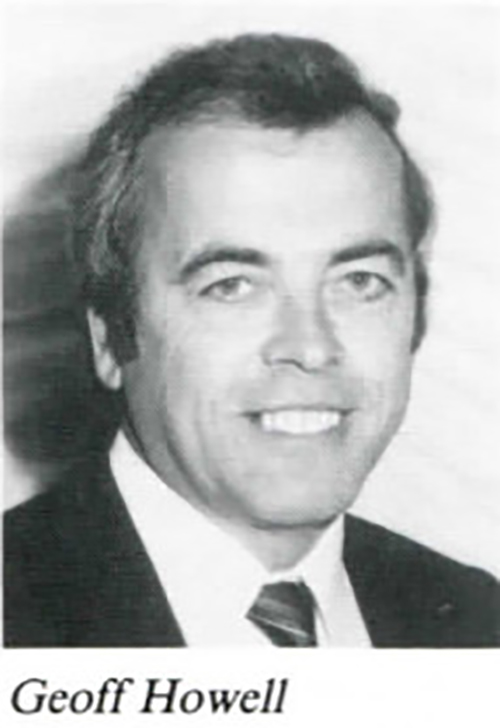Geoff Howell

I started at Mitcheldean with British Acoustic Films Ltd (BAF) on 10th August 1953.
I joined what was then called ‘The Learnership Scheme’ which was to all intents an Apprenticeship. In those days employed on the Mitcheldean site was some 350-400 people. The factory made the majority of parts that went into the assembly of Bell & Howell 8mm and 16mm cameras and projectors.
Some components were bought, such as raw die-castings but all machining was done in house.
The range of manufacturing processes was phenomenal. There was a Machine Shop consisting of a Milling Section, Drilling Section, Hobbing (gear cutting), Grinding Section, Auto Section (screw cutting), Capstan Section, Fettling Section (where raw die-castings were prepared prior to machining). Supporting all of this was a Cutter Grinding Department. All of what has so far been mentioned was housed in one single storey building, long since demolished.
The main entrance to the factory was on the main street in Mitcheldean. On the right as you came in there was a ‘clocking in’ station and again on the right was a Sheet metal Section consisting of presses, guillotines and Spotwelders. I believe the building where the Sheet metal was housing was the original stables for Wintle’s Brewery.
There were many other processes carried out onsite. A fairly large Nissan Hut type building housed a Heat Treatment Section where various processes took place, including case hardening using a chemical called Potassium Cyanide. Looking back I’m not sure what today’s Health & Safety world would think.
Further significant departments were the Finishing Sections which included painting and plating, all carried out onsite. So the range of skills required was extensive.
Then there was Final Assembly building which took place in what is known as the Maltings. Here various floors were dedicated to the assembly and testing of 8mm & 16mm cine cameras and projectors made under Licence from Bell & Howell, Chicago, USA. Incidentally onsite was an American Representative for Bell & Howell and in those days the Company owned a house in Estcourt Road, Gloucester, where the gentleman resided.
Supporting all this manufacturing activity were various other departments including:
• Tool Room
• Tool Design office
• Purchase office
• Goods Inwards
• Despatch
• Experimental & Small Batch departments
• Wages / Accounts
Small Batch Department: This section when I started there in 1953 made Sparcatron heads for Company in Gloucester known as Implemented Diamonds. I believe these were used in the Tool Making industry.
A further unit that was made was a Microfilming unit for photographing cheques for which Bank I can’t now remember. I can remember all of this was very much in line with the precision required in the manufacturing of Cine Equipment.
The Experimental Department of which I was fortunate to spend between 6 and 12 months made equipment for Film Studios. These included Film Printers and Splicers.
The Film Printer was used to print off multiple copies from a master film, this enabled the film companies to distribute films to various cinemas.
The Film Splicers were used in the editing process to enable the film editing people to insert, cut and re-join films very precisely so that the join would be undetected.
Again this equipment was very much in line with precision needed in the manufacture of Cine Equipment.
Another interesting project taking place in the Experimental Dept. was the manufacture of gearboxes and various other components for cameras. Marconi were working for filming off a television screen, bearing in mind this was before the days of video recording.
Looking back on these days of British Acoustic Films (BAF) the skills that were available in Mitcheldean were incredible. When you consider the tolerances they were using and producing parts to +/- .005 considered common plus +/- .0005 frequent.
To be truthful when Xerox machines came along it was more like building a combine harvester compared to the Cine Equipment they had been used to. However we must not knock Xerox, this equipment came along and gave us all a good living and pensions.
Buses provided by Edwards and Sons of Joys Green provided transport to and from the factory pick-up points at various locations: Gloucester, Cinderford, Ross-on-Wye, Lydbrook with various stops on the route.
When I started in 1953, many of the of the people had come down from London when the factory moved out to avoid the blitz, because originally they were making Plotting Tables and Searchlights for the war effort. Occasionally bits and pieces from those days could still be seen around the site. The old air raid shelters were there, later housing the Air Compressors supply to the whole site.
The emergency water tank was still there.
Interestingly one of the original employees, Sam Newman, of Wintle’s Brewey still worked at BAF.
Names of apprentices that I can recall:
• Tony Kibble
• Bob Morse
• John Stevens
• Roy Harvey
• Dave Foster
• Ray Reed
• John Brain
Names of people I recall who came down from London:
• Bob Baker
• Pat O’Hare
• Tommy Knight
• Mrs Knight
• Stan Richardson
• Len Hart
• Ray Camp
• Cyril Woodward
• George Fordham
• B C Smith
• Jack Wood
• Gordon Fisher
From Engineering Apprenticeship what an opportunity BAF offered, when you consider the exposure you had to virtually all the manufacturing processes.
The other thing we have to be thankful for is the Vision of Rank Organisation Directors for their tie up with Bell & Howell and then latterly with Haloid/Xerox.
Geoff Howell
